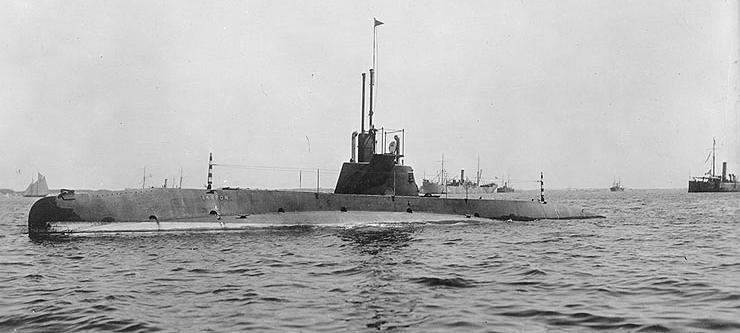In commission 1908–1919 | Built 1906–1909 | |
 | ||
Builders | ||
The C-class submarines were five United States Navy submarines built by the Fore River Shipbuilding Company in Quincy, Massachusetts, under a subcontract from the Electric Boat Company. Built between 1906 and 1909, and in commission from 1908 to 1919, all five were subsequently sold for scrap in 1920. They were considerably larger than the preceding B class at 275 tons submerged vs. 173 tons submerged, and were the first United States submarines with two-shaft propulsion, doubling the machinery of the B class.
Contents
Design
These vessels included some features intended to increase underwater speed that were standard on United States submarines of this era, including a small sail and a rotating cap over the torpedo tube muzzles. For extended surface runs, the small sail was augmented with a temporary piping-and-canvas structure. Apparently, the "crash dive" concept had not yet been developed, as this would take considerable time to deploy and dismantle. This configuration remained standard through the L class, commissioned 1916-1917. The streamlined, rotating torpedo tube muzzle cap eliminated the drag that muzzle holes would otherwise cause. In the stowed position, the submarine appears to have no torpedo tubes, as the holes in the cap are covered by the bow stem. This feature remained standard through the K class, after which it was replaced with shutters that were standard through the 1950s.
Service history
The C-class submarines served in the Atlantic Fleet. On 20 May 1913, the five C-class boats of the First Group, Submarine Flotilla, Atlantic Fleet, departed Norfolk, Virginia for Guantanamo Bay, Cuba. They exercised in Cuban waters, principally conducting torpedo exercises, until 7 December 1913. On that date the C-class boats, now of the redesignated First Division, escorted by four surface ships, sailed for Cristóbal in the Panama Canal Zone. Five days later the ships completed the 700-mile (1,100 km) passage, at that time the longest cruise made by United States submarines under their own power. The submarines remained at the Coco Solo submarine base until they were decommissioned in 1919 and scrapped in 1920.
